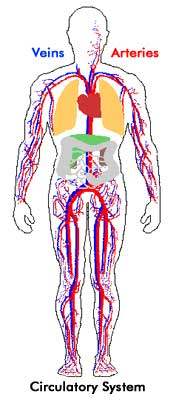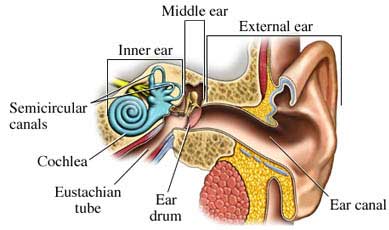Updated: August 2015
By Barry Keate
Barry Keate, has lived with tinnitus over 40 years and has published 150+ research articles on numerous aspects of tinnitus. He is an expert on the condition and a well-known advocate for those with tinnitus.
 Pulsatile tinnitus is the type of ear noise that is perceived as a rhythmic pulsing that is often in time with the heartbeat. It can be experienced as a thumping or whooshing sound. It is sometimes referred to as vascular tinnitus because in the majority of cases, it is related to disturbances in the blood flow. About 3% of tinnitus patients experience this type of tinnitus.
Pulsatile tinnitus is the type of ear noise that is perceived as a rhythmic pulsing that is often in time with the heartbeat. It can be experienced as a thumping or whooshing sound. It is sometimes referred to as vascular tinnitus because in the majority of cases, it is related to disturbances in the blood flow. About 3% of tinnitus patients experience this type of tinnitus.
Pulsatile tinnitus usually originates within the blood vessels inside the head or neck region when disturbed blood flow occurs. This results from either increased blood flow or a narrowing of the opening of the blood vessel, both of which result in turbulent blood flow that can be heard in the ears. In this regard, it is totally different from and independent of continuous tinnitus which results from damage to the cochlea and/or hearing nerve.
It is very possible to have both pulsatile and continuous tinnitus together. People who have both of these generally say the pulsatile component is the more bothersome.
It is important to investigate all instances of pulsatile tinnitus. In some cases, a serious underlying condition could exist. In rare cases, this can lead to a catastrophic event such as stroke. A series of tests, beginning with an examination of the head and neck by a physician familiar with the condition, through complex imaging techniques, is performed. Individuals who find that the initial imaging results do not reveal abnormalities should insist on further examination and investigation. It is possible to misread or miss these trouble spots that may be tangled in other structures or hidden by bone or other tissue. Newer imaging techniques, such as Magnetic Resonance Angiography and Carotid Artery Ultrasonography, have been employed that help determine the site of the problem in the majority of pulsatile tinnitus cases. The cure rates for pulsatile tinnitus are quite high once the problem area has been identified. The correct specialist to consult on pulsatile tinnitus is a vascular surgeon.
The following section describes some of the more common causes of pulsatile tinnitus and relevant therapies.
1 – Benign Intracranial Hypertension (BIH). This is a condition where there is increased pressure of the cerebrospinal fluid that bathes the brain. The majority of these patients are young females who are generally overweight. Other symptoms of BIH may include hearing loss, ear fullness, dizziness, headaches and visual disturbances. Management of this condition includes weight loss and administration of a diuretic. Most patients improve dramatically with weight reduction alone.
2 – Glomus Tumor. This is a benign vascular tumor usually located in the ear or just below the ear at the skull base. It consists of a mass of intertwined blood vessels. Hearing loss is also a common symptom. Young patients are usually treated surgically, to remove the tumor, while older patients may need no treatment since they are very slow growing.
3 – Atherosclerotic Carotid Artery Disease. Atherosclerosis is the narrowing of the artery due to cholesterol build-up on the artery wall. This reduces the opening resulting in turbulent blood flow that produces pulsatile tinnitus. This usually occurs in older patients with a history of hypertension, elevated cholesterol, diabetes, angina and smoking. The condition can usually be controlled through medication.
4 – Intracranial Vascular Lesions. These include aneurysm and arteriovenous malformations, which is an abnormal connection between an artery and a vein.The blood flows directly from a high pressure artery to a lower pressure vein without going through the capillaries. Either aneurysm or arteriovenous malformation can lead to bleeding in the brain and can be extremely dangerous. Therapies include surgery and embolizing (closing off) the blood vessels.
5 – Middle Ear Effusion. The middle ear is normally an air-filled space. If fluid accumulates in the middle ear due to infection, inflammation or Eustachian tube dysfunction, pulsatile tinnitus can result. It is sometime accompanied by decreased hearing, a feeling of fullness, and may also include pain. This is most often treated with antibiotics, decongestants, nasal sprays, etc. or sometimes surgery.

6 – Venous Hum. Patients who are pregnant, anemic, or have thyroid problems, may develop increased blood flow through the jugular vein, the largest vein in the neck. The jugular vein traverses the middle ear and any turbulent flow in the vein can be heard in the middle ear as a “hum” which may or may not fluctuate with the pulse. Correction of the underlying problem generally results in improvement or resolution.
7 – Hypertension. There are reports of patients with high blood pressure whose pulsatile tinnitus started after they began taking blood pressure medication. Tinnitus subsided in most after four to six weeks. For the remainder, a change to another medication resolved the issue. Others developed tinnitus from elevated blood pressure and it resolved after medication reduced the pressure.
8 – Twisted Arteries. Twisted arteries in the head and neck cause turbulent blood flow leading to pulsatile tinnitus. It generally does not require treatment.
These are the primary causes of pulsatile tinnitus but not an exhaustive listing.
9 – Other Causes. Other causes can include Arnold-Chiari malformation where an elongation of the cerebellum is pushed down through the opening of the base of the skull, blocking the flow of cerebrospinal fluid. Hyperthyroidism, a condition where the thyroid gland overproduces hormones, can cause pulsatile tinnitus. Iron deficiency can cause pulsatile tinnitus in some cases. Iron deficiency thins the blood and it rushes through the bloodstream. Anything that increases blood flow can cause pulsatile tinnitus. Muscle spasm in the soft palate can cause a clicking sound which is rapid (60-200 beats per minute), repetitive and intermittent. This is associated with multiple sclerosis, small vessel disease, tumor or degenerative neurological disorders. The small muscle attached to the stapes bone in the middle ear can spasm which produces a crackling or rumbling noise. There are other, mostly rare, causes of pulsatile tinnitus as well as those mentioned here.
If pulsatile tinnitus is caused by turbulent flow in arteries, pressure applied to the upper neck on the side of the tinnitus should alter or reduce it. If it is venous in origin, the Valsalva maneuver may improve it. This is performed by forcibly exhaling against closed lips and pinched nose, forcing air into the middle ear, provided the Eustachian tube is open. Neither of these is a fool-proof way of identifying or  alleviating the problem but positive results may lead to a better diagnosis by a physician.
alleviating the problem but positive results may lead to a better diagnosis by a physician.
Arches Tinnitus Formula® is helpful in many cases of pulsatile tinnitus. The mechanism of action is Ginkgo biloba extract reduces the viscosity of the blood and arterial pressure which in turn reduces the throbbing or pulsing effect. People with pulsatile tinnitus should always undergo a thorough evaluation to ensure that serious consequences, such as stroke, will be prevented.
